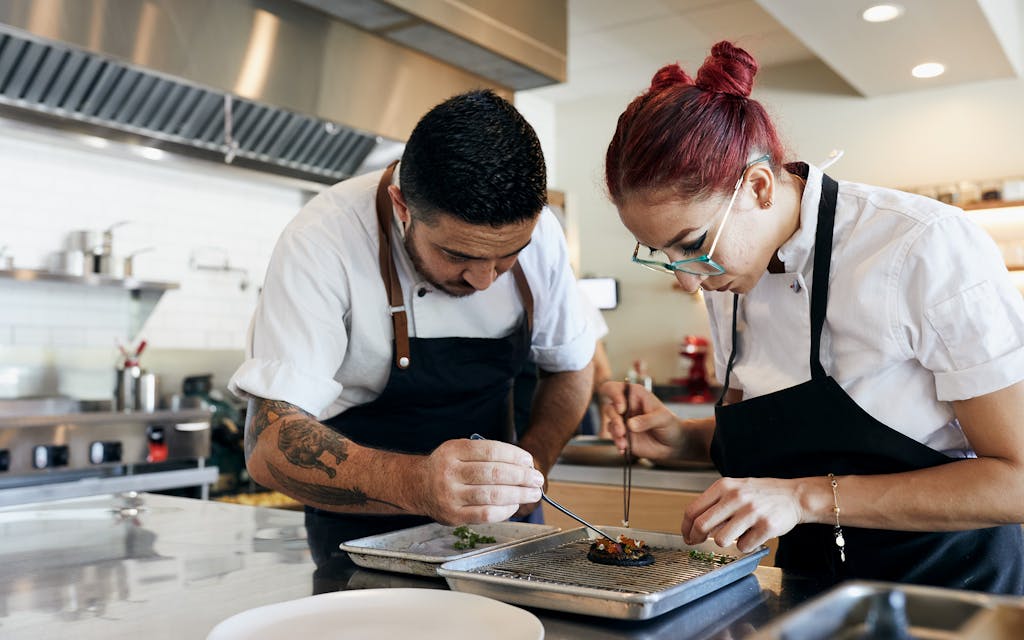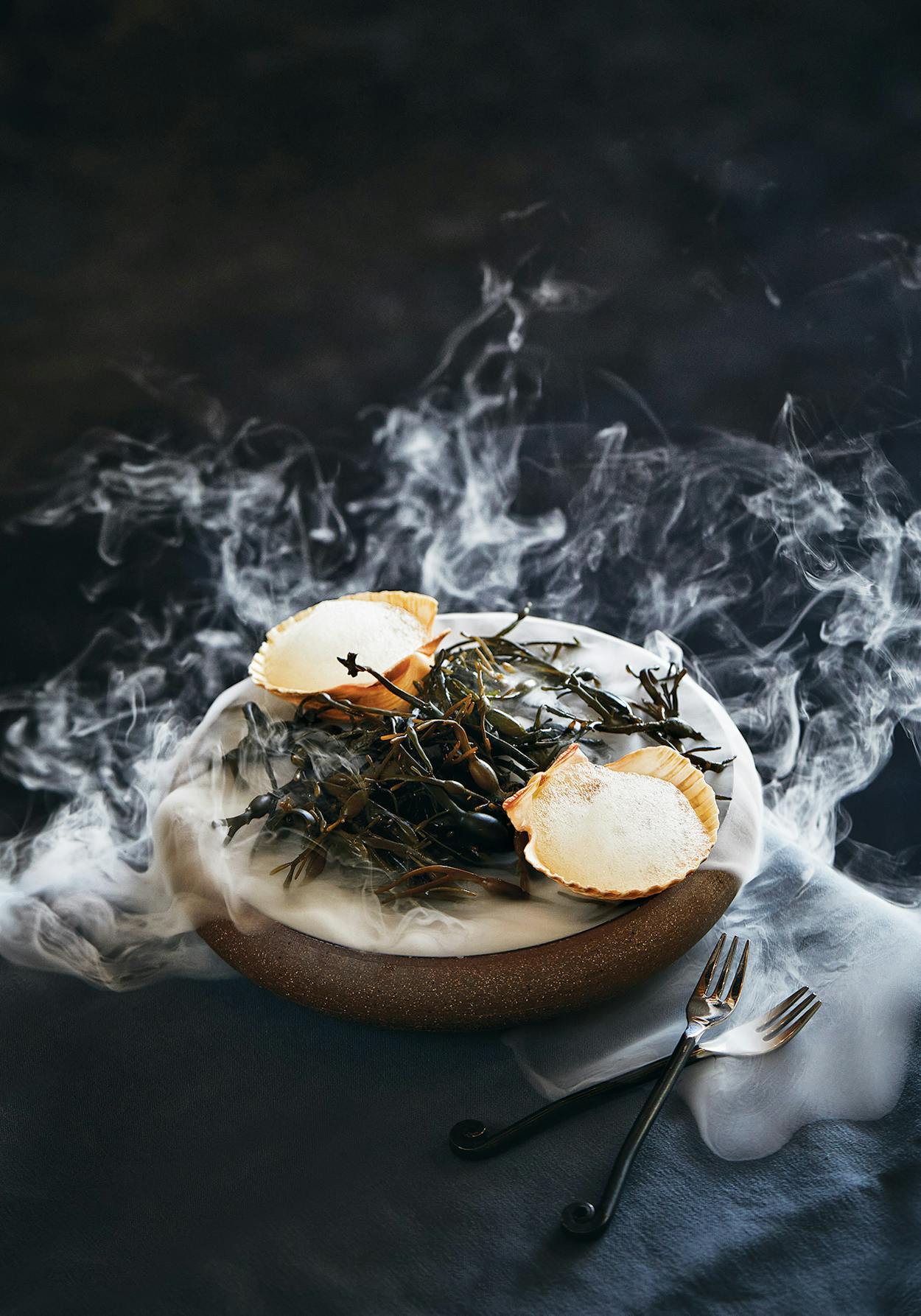Featured in the San Antonio City Guide
Discover the best things to eat, drink, and do in San Antonio with our expertly curated city guides. Explore the San Antonio City Guide
Something ice cold is always in order on a warm San Antonio evening, so as soon as we arrived at Mixtli, my friend Gini and I slid into chairs at one of thirteen well-spaced tables and ordered lavender lemonades. Then we took a minute to gaze around the room with its high ceiling, clean-lined furniture, and pops of blue in everything from glassware to whimsical art. The masked staff moved quietly between the dining area and open kitchen while we inspected the ten-course tasting menu, which changes roughly with the seasons, each iteration focusing on the culinary traditions of one of Mexico’s wildly varied regions, states, or historic periods. This was my first visit to Mixtli in several years, and I was happy to see that chef-owners Diego Galicia and Rico Torres have stayed true to their mission: exploring Mexican cuisine from ancient to modern times through the lens of their singular imaginations.
Sustaining that sort of vision is not always easy when a small, acclaimed restaurant expands or moves—and Mixtli has recently done both. It’s no longer in its original location, the charmingly renovated railroad car in an Olmos Park shopping center where it all started. Back in 2013, the then-30-year-old Galicia, who is from Toluca, Mexico, and 35-year-old Torres, an El Paso native, had taken a leap of faith, abandoning solid jobs to follow a risky, quixotic path. (Galicia remembers, “I was like, ‘Hey, man, if you jump, I’ll jump.’ ”) They pooled $15,000 and leased the railcar, which they turned into a restaurant with one long twelve-seat communal table. The poetic name they chose, pronounced “meesh-tlee,” means “cloud” in Nahuatl, the language of the Aztecs and some of their descendants. Initially, Galicia and Torres weren’t even convinced that diners would want to eat dishes inspired by ancient ideas, so they were astonished when the place became a runaway hit. Foodies flocked from Chicago, New York, and other far-flung cities, and professional recognition followed. In 2017 Food & Wine named the pair to its list of best new chefs in the country. A year later they were semifinalists for the James Beard Foundation’s Best Chef: Southwest award. (When he learned of the nomination, “I couldn’t stop crying,” Galicia told me at the time.)


But even as the accolades piled up, the appeal of the tiny quarters began to wear thin. “There were no windows in the kitchen,” says Galicia. “That gets to you after a while.” As demand for those twelve seats skyrocketed, the owners had a new dream: ditch the railcar. After considerable searching, they found an airy location in the flourishing Southtown neighborhood. True to form, the thrifty co-owners designed the space and selected the furniture and art themselves. The new place opened in June.
Sitting in that new room, Gini and I sipped our drinks, eager to see what novelties the chefs had devised for the inaugural menu, which paid homage to the cuisine of Oaxaca. Would there be a Zapotec dish? An edible insect or two? Soon, a tray arrived bearing two beautifully browned, perfectly spherical dinner rolls. Well, of course—French ingredients and cooking techniques had been a key part of Mexico’s culinary culture even before the five years of French occupation under Napoleon III in the 1860s. One bite later, we looked up simultaneously. These were the most ethereal—no, celestial—rolls either of us had ever eaten. Accenting the yeasty goodness was a subliminal hint of infused smoke. And that sweetness? Executive pastry chef Sofia Tejeda had added whey for extra depth. Alongside the bread were a small wooden bowl of butter topped with jet-black huitlacoche salt (from Mexico’s intriguing—and delicious—corn fungus) and a matching vessel filled with olive oil scented with nasturtium leaf.
We sat back and thought, How are they going to top this? I read the second listed item. “It says ‘ceviche of calabacita,’ ” I remarked, wondering what a squash ceviche could be. The plate arrived, and we were further perplexed. “Isn’t that a granita?” The green-and-yellow composition turned out to be both. On one side was a tidy mound of ice crystals from a frozen puree of peas and serrano peppers, while on the other was a lime-juice-tossed “ceviche” of not just squash but also other vegetables, including delicately charred cucumber. Epazote vinaigrette added an herbal punch, and underneath it all was a layer of garlicky avocado mousse. “You should stir everything together,” our server instructed. We did, trying to include some of the dish’s final garnish—crunchy chicatana ants—in each bite. These croutons of the insect world, about three-quarters of an inch long, are mild, a little bit nutty, and quite tasty. Just like that, we had been swept into Mixtli’s carefully planned evening, drama building with the entrance and exit of each course.

The next to arrive was a black disk, about the size of a large cookie, sprinkled with glistening orange trout roe and bright-green sunflower sprouts. Under the colorful garnish was a shiny thatch of black sesame seeds. The middle layer held the generous payoff: a spread made from the rare, smoky Oaxacan chile called pasilla mixe and finely chopped freshwater mussels—tichindas—from the same region. The bottom was a tidy round cake of squid-ink-flavored masa (not to worry—it was sweet, not fishy). “Pick it up,” our server said. The dish, eaten by hand, made for savory, almost meaty bites. In my several decades of reviewing Texas restaurants and visiting some of the world’s most celebrated dining venues, I’ve never had anything quite like it, which, I suspect, is exactly what Galicia and Torres were going for.
After the first few courses, we fell in step with Mixtli’s pacing, savoring each item, happy we had no decisions to make. We watched as new guests settled in and reacted with astonishment to the dishes we had just enjoyed. During the occasional brief lull, Torres or Galicia might appear with an unusual ingredient, kneeling beside a table to talk about it with genuine enthusiasm.
The most sensational presentation came about halfway through, in a cloud of dry ice, the white vapor billowing up from beneath a bed of seaweed arranged in a smooth earthenware bowl. Atop the dark green vegetation were two white seashells, each holding a velvety bay scallop that had been poached in ajo-chile butter. Of the remaining courses, the two most straightforward were obviously calculated to please carnivores. One was a hunk of ibérico pork tenderloin belted in hoja santa leaves, which lent just a touch of anise and eucalyptus. Under the pink sous vide protein was a marigold-hued mole of chile costeño amarillo blended with Texas-grown peanuts. The other substantial item was tender grass-fed ribeye, four medium-rare slices sided by an ebony pool of mole negro. This dish was the showplace for a particularly rare chile, the chilhuacle negro, one of many that the owners have gone to considerable lengths to source. “Some are so scarce,” To-rres told us, “that they’re produced in only one or two little villages.”


But the course that left us with the biggest smiles was the playful finale, an array of sweets called Study of Oaxaca. Created by Tejeda, it arrived on an imposing wooden platter that was in fact a cross section of a small tree limb—beautiful, striking dinnerware is a distinct part of the pleasure of a meal at Mixtli. The base of the dessert was a slice of almond cake half-buried in an avalanche of crumbs, finely chopped almonds, nibbles of dried fruits, and colorful flower petals. On top was a milky white dome of what looked like sherbet but was in fact a custard inspired by the Zapotec dish nicuatole. It was so smooth that I would never have guessed the base was masa. A fat squiggle of chocolate ganache completed the creation.
At the end of the meal, Torres stopped by to ask, “Are you going to the bar for coffee?” We were tempted. Café de olla—fragrant coffee spiced with cinnamon and raw sugar and brewed in a clay pot—is one of Mexico’s loveliest traditions. But at this point I couldn’t eat another bite, so I just peeked into the comfy adjacent room, which features an appropriate art installation of a glowing cloud, and promised I’d indulge next time (no reservations are required for the bar, which also offers a snack menu).
Walking out into the late summer night, I felt the way I had the first time I ate at Mixtli, in the railcar, eight years ago: exhilarated. Also, frankly, relieved. I had worried that the pressure of the pandemic would have forced the two owners to scale back, to go more mainstream. But they are as ambitious as ever. I remembered something that Galicia told me back in 2018. “This restaurant is going places,” he said. “Rico and I just follow it. We just run behind it, trying to keep up. It’s become a very special place.”
It was then, and it still is.
Mixtli
812 S. Alamo, San Antonio
210-338-0746
D Tue–Sat.
$$$$
Opened October 1, 2013; reopened June 22, 2021
Mixtli’s menu changes four times a year. For the fall, the cuisine of Chiapas is being featured until December 18. Online reservations by prepaid ticket only, $125 per person (optional wine pairings $50 per person; café de olla for two, $20).
This article originally appeared in the November 2021 issue of Texas Monthly with the headline “More to Love at Mixtli.” Subscribe today.
- More About:
- Pat’s Pick
- Restaurant Reviews
- San Antonio









